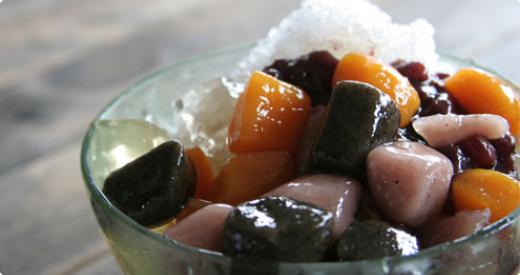
Traditional Chinese desserts are undergoing a renewed popularity even among the younger set in Hong Kong according to a recent story in the South China Morning Post. This resurgence comes from several local chains reinterpreting such classics as Taiwanese shaved ice, tang sui sweet soups and dou hua soft tofu pudding. Some have observed that the reinterpretation of these once old-fashioned sweets have lured the younger generation away from Western desserts.
Discussions about East Asian dessert can be polarizing―generally positioned in an East vs. West framework with hard sweets, rice cakes, tapioca, herbal jellies or sweet beans as Asian desserts and cakes, cookies, ice cream, chocolate or puddings as Western desserts. This notion has proliferated threads on food forums arguing why Asian sweets do not agree with the Western palate or how the concept of dessert does not exist in Asia. It is true that, historically, Asian sweets are considered more of snack than a specific course set aside to finish off the meal. And many of the sweets shops in Asia are directly influenced and modelled after bakeries and patisseries from the West. However, it is interesting to consider the ways in which these Western-style desserts have evolved and adapted to something Asian in its own right.
One obvious example is the dan ta egg tarts which is a fixture of Hong Kong tea cafes ( cha chang ting ) and bakeries. The dan ta and its Macanese cousin, the pasteis de nata , originated from a traditional Portuguese custard pastry. However, over the past half century, the egg tart has evolved to become an iconic and celebrated dessert in Hong Kong and Macau―considered a distinct part of the local cuisine. Similarly, “paper-wrapped” cake became popular in Hong Kong during its years under British rule and came from the English sponge cakes served at tea time. Because butter was a prohibitively expensive product during colonial times, Chinese bakers substituted the ingredient with corn oil yielding simple airy cake that is considered uniquely Chinese.
In our research, we were surprised to learn that chocolate was introduced to Japan as early as 1614 following Japanese feudal lord Masamune Date’s trade mission to Seville, Spain. Creating sweets for the imperial family since the 16th century, the famed confectionary house Toraya has for centuries included chocolate as regular ingredient in their desserts such as the thickly jellied yokan flavoured with adzuki red beans and sweetened cacao. Royce, one of Japan’s leading chocolatiers, pioneered the technique of nama choko which is essentially a Japanese style of truffle made from mixture of melted chocolate and heavy cream. At the 2011 Salon du Chocolat in Paris, patissiers Susumu Koyama garnered titles with chocolates that incorporate ingredients such as fermented tofu or kuro shichimiseven-spice powder. Sadaharu Aoki, another prominent chocolatier, have made sweets incorporating matcha green tea, black sesame and sansho pepper flavours.
Ice cream made its first known debut in Asia circa the 7th century, enjoyed by King Tang of Shang in China. This frozen concoction made from fermented buffalo, cow and goat milk had little resemblance to the well-loved modern day treat. It is believed that the explorer, Marco Polo, introduced Chinese techniques for of making ice cream back to Italy where sherbets and milk ices became fashionable. However, quibbling over the origins of ice cream misses the point. This dessert is an example of how culinary ideas are passed from one culture to another so that they develop into unique iterations of culturally universal foods. In other words, neither the West nor the East can really claim ownership; we all scream for ice cream as the saying goes.
Many Asian countries have variant of an ice dessert which does not include cream or eggs, and instead relies on sweet syrups and condiments to flavour crushed or shaved ice. Ice kachang from Malaysia is one example where grated ice is packed into a ball with aloe vera jelly, red beans, sweet corn and attap chee (palm seeds) with brightly-coloured syrup and condensed poured on top. For Taiwanese tsua bing , a snowy mound of finely shaved ice is covered by a combination of fruit, sweet beans, tapioca, sweetened nuts, jellies or other toppings mixed with condensed milk to create the slushy texture of ice milk. The Korean patbingsu is yet another variant of shaved ice with a different mix of toppings. It is deconstructed form of ice cream wherein the ice is merely the vehicle for a myriad of flavours and texture.
These are but a few examples. The dessert culture in Asia has developed differently in each city far beyond that “East-meets-West” cliché. The idea that Cantonese desserts are making a comeback is premised on the notion that these so-called old-fashioned sweets became ever became unpopular to begin with. If anything, love for traditional Asian dessert flavours are and have been stronger than ever, incorporating them as elements of cakes, ice cream, chocolate, or what is generally categorised into Western-style dessert. We invite our readers to think of other examples of desserts and the subtle differences that make them uniquely Asian.
Related stories :
– Find out Asian Palate’s five favourite Thai desserts and how to make them in our compilation of video recipes.
– Last year, Jeannie made a case for buying up sweet wines which have fallen out of fashion in recent years.
– From ma po tofu to cheesecake, “Asia’s healthy cheese” a.k.a. tofu can is a versatile ingredient that can be found in surprising places.









